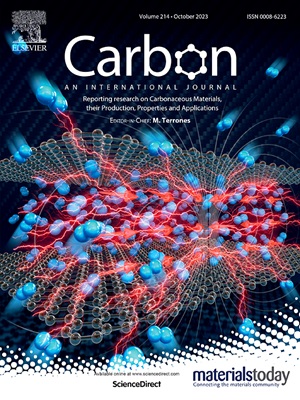Multifunctional bamboo-derived porous carbon for efficient electrical-thermal energy management and electromagnetic interference shielding
IF 10.5
2区 材料科学
Q1 CHEMISTRY, PHYSICAL
引用次数: 0
Abstract
Joule heating is an effective heating method but is often limited by the extra heat dissipation. To address this, we developed bamboo-derived porous carbon (CB) for use as Joule heaters, which exhibits remarkable electrothermal conversion efficiency, driven by its high electrical conductivity and porous structure. The natural porous structure of bamboo reduces electrothermal conversion losses, allowing for a steady-state saturation temperature of 164 °C at 2 V. The microcrystalline graphite structure, 3D microporous channels, and low thermal conductivity (0.03 W m−1 k−1) contribute to an electrothermal conversion efficiency of 99.14 %. Moreover, CB heaters demonstrate remarkable surface heating and cooling rates of 114.36 °C/min and 113.78 °C/min, respectively. CB Joule heaters are suitable for de-icing and body-assisted heat treatment at various applied voltages. Its unique gradient porous structure also provides asymmetrical electromagnetic interference (EMI) shielding performance, with high absorption losses concentrated in the sparse inner layer. This sustainable CB material has significant potential for advanced Joule heating and EMI shielding applications.

求助全文
约1分钟内获得全文
求助全文
来源期刊

Carbon
工程技术-材料科学:综合
CiteScore
20.80
自引率
7.30%
发文量
0
审稿时长
23 days
期刊介绍:
The journal Carbon is an international multidisciplinary forum for communicating scientific advances in the field of carbon materials. It reports new findings related to the formation, structure, properties, behaviors, and technological applications of carbons. Carbons are a broad class of ordered or disordered solid phases composed primarily of elemental carbon, including but not limited to carbon black, carbon fibers and filaments, carbon nanotubes, diamond and diamond-like carbon, fullerenes, glassy carbon, graphite, graphene, graphene-oxide, porous carbons, pyrolytic carbon, and other sp2 and non-sp2 hybridized carbon systems. Carbon is the companion title to the open access journal Carbon Trends. Relevant application areas for carbon materials include biology and medicine, catalysis, electronic, optoelectronic, spintronic, high-frequency, and photonic devices, energy storage and conversion systems, environmental applications and water treatment, smart materials and systems, and structural and thermal applications.
 求助内容:
求助内容: 应助结果提醒方式:
应助结果提醒方式:


